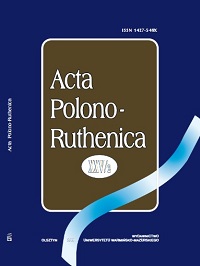Українська картина світу в романі Ігоря Станойоського «Перший університетський день моєї доньки»
Ukrainian language worldview in the novel of Igor Stanojoski My daughter’s first university day
Author(s): Hanna YaminskaSubject(s): Language studies, Language and Literature Studies, Applied Linguistics, Studies of Literature, Eastern Slavic Languages, Philology
Published by: Wydawnictwo Uniwersytetu Warmińsko-Mazurskiego w Olsztynie
Keywords: Ukrainian picture of the world; language picture of the world; Macedonian perception; times realities; national identity;Chornobyl;
Summary/Abstract: Igor Stanojoski is a modern Macedonian writer who combines different literary genres in his novels. Despite his Macedonian origin, almost all of his works have Ukrainian characters, through whom the author shows the reader the Ukrainian view of the world. In the novel My Daughter’s First University Day, Stanojoski through the prism of the images of the main characters and the city of Lviv projects the picture of Ukraine. The text is written in Macedonian and is intended for the Macedonian reader, which allows us to look at such concepts as the national identity of one nation (Ukrainians) from the point of view of another nation (Macedonians). An important role in the text is given to Chernobyl –not only as a historical, but also a psychological event that changed the course of history and the consciousness of Ukrainians. Projecting the image of Ukraine through the Chernobyl tragedy on the main character as the personification of the mother, we can observe a direct allusion to the image of Ukraine, to its formation on the path to independence. Lexical and grammatical constructions introduced by the author in the text take on an important role in the linguistic picture of the world of Ukrainians through the prism of Macedonian perception. These constructions are presented in the Macedonian language but sometimes have Ukrainian semantics. As a result of such a combination, we get a kind of symbiosis of languages which is created specifically by the author for a deeper perception of the Macedonian recipient of the linguistic identity of Ukrainians. The Ukrainian linguistic picture of the world is presented from the angle of the Macedonian perception. They are mentally and grammatically different from each other, but due to an analysis of such seemingly related, but still different languages, we can note a specificity in the perception of national identity of one people through the linguistic perception of another people. This perception helps us to create a separate category in understanding the linguistic picture of the world and reject new opportunities for deeper analysis of the cultural and historical image of the whole nation.
Journal: Acta Polono-Ruthenica
- Issue Year: 2/2020
- Issue No: XXV
- Page Range: 61-76
- Page Count: 16
- Language: Ukrainian

